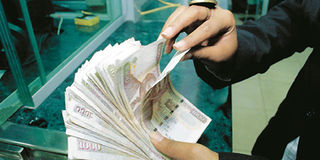Mystery of Sh164bn smuggled into Kenya

A customer counts her money in a bank. Analysts are scratching their heads over Sh164 billion in the Kenyan economy whose source cannot be explained for. Photo/FILE
A massive Sh164 billion in hard currency has found its way into the Kenyan economy — and the government is unable to explain its source.
The $2.1 billion inflow has left government statisticians and donors scratching their heads for answers, fuelling concerns that Kenya may be turning into a money laundering destination by Somali pirates.
The large foreign currency injections are captured in the latest balance of payments statistics published by the Central Bank of Kenya.
Ransom money
It is all happening against a backdrop of intense speculation that millions of dollars in ransom money paid to Somalia-based pirates end up in Kenya. Profits from smuggling and other suspect foreign funds in the economy of the lawless state may be another source of the money.
In addition, the large Somali Diaspora around the world could be remitting the money, which ends up in the property sectors of Nairobi and other major towns in Kenya. In January this year, the matter prompted the Office of the President to order investigations into trends in property purchases in Nairobi.
On paper, the massive figure is reflected in the books of the government as ‘errors and omissions’ on the capital and financial accounts. But in reality, this huge figure is the total of the large foreign currency inflows, whose sources the Central Bank of Kenya cannot explain.
Even more intriguing is the fact that there has been a massive increase within one year of foreign exchange whose sources cannot be traced. The statistics show that as at January last year, the figure for ‘errors and omissions’ in the country’s balance of payments accounts was at $1.1 billion.
Export earnings
Having risen to $2.1 billion, the current level represents a massive 100 per cent increase within a year. The mysterious billions are over and above the combined last year’s export earnings from coffee, tea and horticulture. As a matter of fact, the line ‘errors and omissions’ has grown into the single largest item in the economy’s balance of payments statistics.
The riddle of the mysterious billions has quickly become a major talking point within both Nairobi’s financial community and donor circles. Central Bank of Kenya governor Njuguna Ndung’u conceded that the strange inflows had become a big worry. He said the cash was “artificially driving the country’s balance of payments surplus”.
“We do not know where this money is from,” he added, promising that the Central Bank was designing new systems to trace the sources of such funds. The International Monetary Fund (IMF), which keeps close tabs on international capital flows, has already initiated discussions on the issue with the government, Central Bank of Kenya and some of the large commercial banks and foreign currency dealers.
According to IMF senior resident representative W. Scott Rogers, part of the billions flowing into the economy may be coming from Somali pirates, but he stressed that the situation was not wholly attributable to such activity. He told the Daily Nation that difficulties in capturing foreign exchange inflows by expatriates, the donor community and international NGOs had clearly aggravated the situation.
He also disclosed that the Kenya National Bureau of Statistics had commissioned a survey on all foreign exchange inflows not captured in official reporting channels. Prof Ndung’u maintained that since Central Bank was already receiving returns on Diaspora remittances from banks every month, it will now ask all commercial banks to provide it with returns on official donor flows coming through the banking systems and non-governmental organisations.
“We strongly believe that this is what is missing and giving us a large ‘errors and omissions’ figure we cannot explain”, he added, promising to make public the findings of CBK inquiries. Since last year, Kenya has not been exporting enough, causing dwindling export revenues and a situation where imports far exceed exports.
As at the year ending December 2009, the external current account, which reflects performance of the country’s exports and imports, had worsened considerably, recording a deficit of $2.2 billion compared to a deficit of $2.1 billion in 2008.




